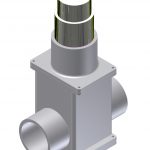Motorized Pinch Valve
Some ideas for a motorized pinch valve using a geared stepper motor controlled by an arduino (for example. or PLR? or raspberry pi?). Need to design and print mounting brackets, gearing mechanism, linear actuator, etc. Design parts in (e.g.) Autodesk fusion 360, print on 3D printer.
Rationale/demand: Pinch valves are good for slurries, fluids containing solids that would clog other valves. Low cost: Existing motorized valves are very expensive.
3/4″ ID x 1″ OD Silcon® Tubing- US Plastics Item #: 54042

premiumaquatics.com – Source for Silicone Rubber Tubing 1″ ID
$7.99 per foot
Item #: MC-5236K29
Idea for moving pinch valve blade up and down in housing: Found at: http://hackaday.com/2015/11/26/upgrading-a-3d-printer-with-a-leadscrew/

Quoting from image source…
Threaded rod is not designed for accurate positioning — it’s primarily designed to be a fastener. You can have issues with backlash, wobble, and they usually aren’t even perfectly straight — not to mention they gunk up easily with dirt and grime. In other words, you’ll never see a threaded rod on a commercial machine. Enter the lead screw. Lead screws are precision machined components used for pretty much all proper CNC equipment. They have almost no backlash, they’re perfectly straight, and they allow for higher load transfers without jamming.
In order to upgrade his Prusa i3, [Daniel] designed and printed his own z-axis carriages to use with the lead screw. If you have a Prusa i3 too, he’s uploaded the design files to Thingiverse. And there’s plenty of info on his blog with instructions on how to do it.


Free solids modeling software from Autodesk (free for students, hobbyists, < $100K/yr startups…) Use it to design valve body…
1. Click on this link to download the zip file of all the sample files associated with each Module. Upload them in Fusion 360.
https://myhub.autodesk360.com/ue29c9141/shares/public/SH7f1edQT22b515c761e12e3a50ab9cda319
2. Begin the training by going through each module in ascending order (01, 02, 03, etc). You can view them in the browser or download them locally.
PDF Modules
01 Introduction https://myhub.autodesk360.com/ue29c9141/shares/public/SH7…
02 Sketch https://myhub.autodesk360.com/ue29c9141/shares/public/SH7…
03 Sculpting https://myhub.autodesk360.com/ue29c9141/shares/public/SH7…
04 Model https://myhub.autodesk360.com/ue29c9141/shares/public/SH7…
05 Manage https://myhub.autodesk360.com/ue29c9141/shares/public/SH7…
06 Assemble https://myhub.autodesk360.com/ue29c9141/shares/public/SH7…
07 Render https://myhub.autodesk360.com/ue29c9141/shares/public/SH7…
08 Drawing https://myhub.autodesk360.com/ue29c9141/shares/public/SH7…
09 CAM https://myhub.autodesk360.com/ue29c9141/shares/public/SH7…







